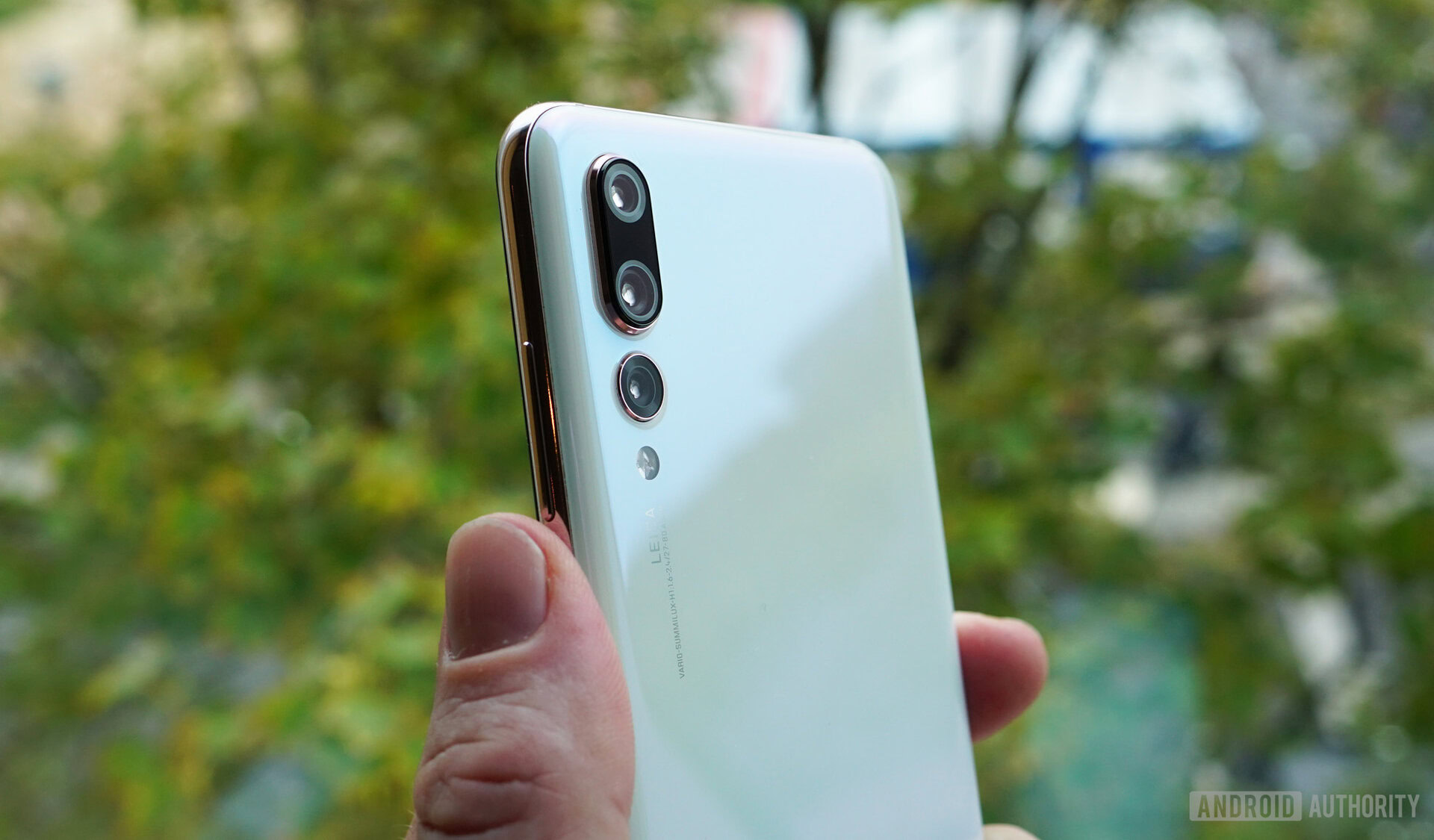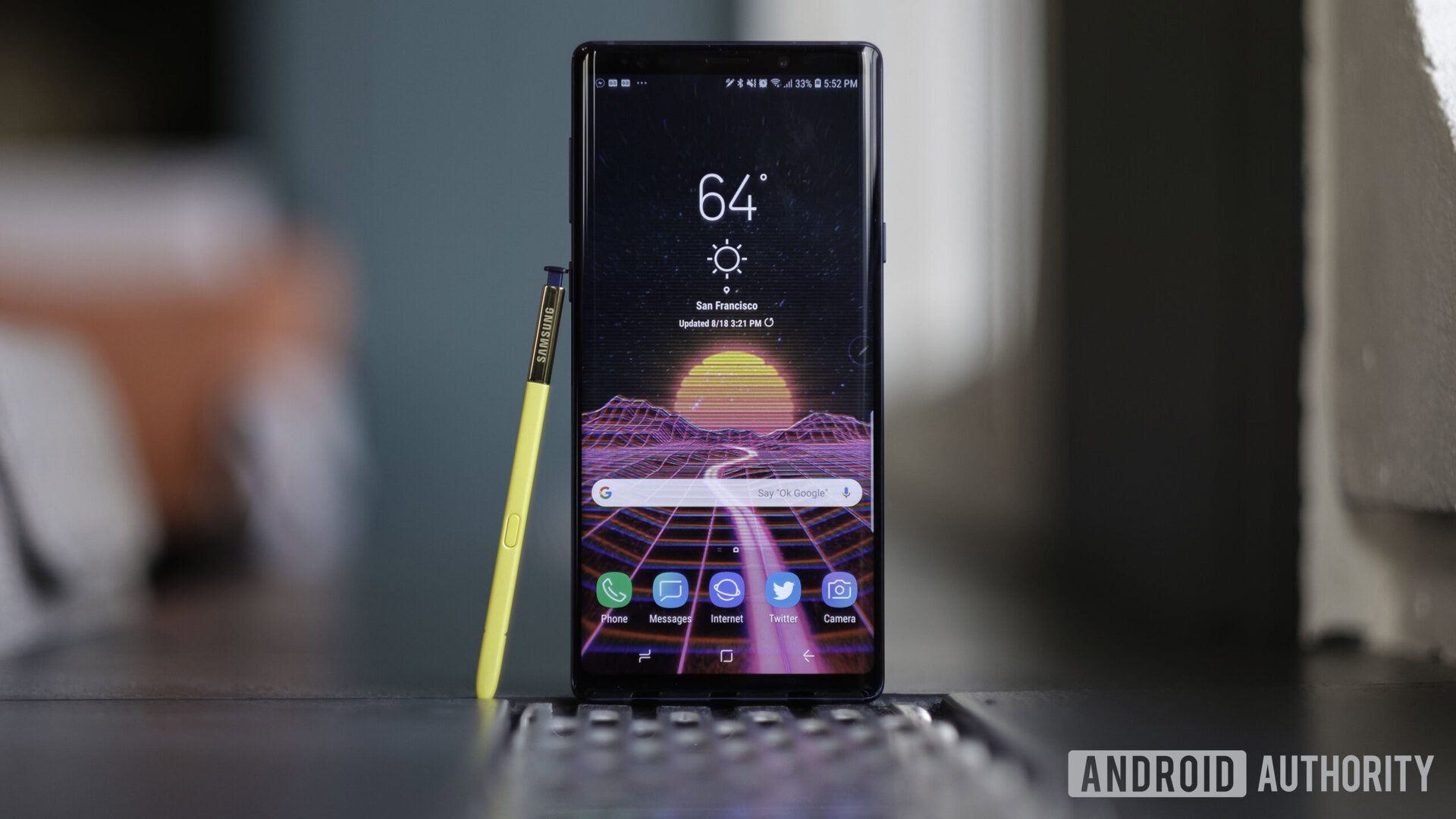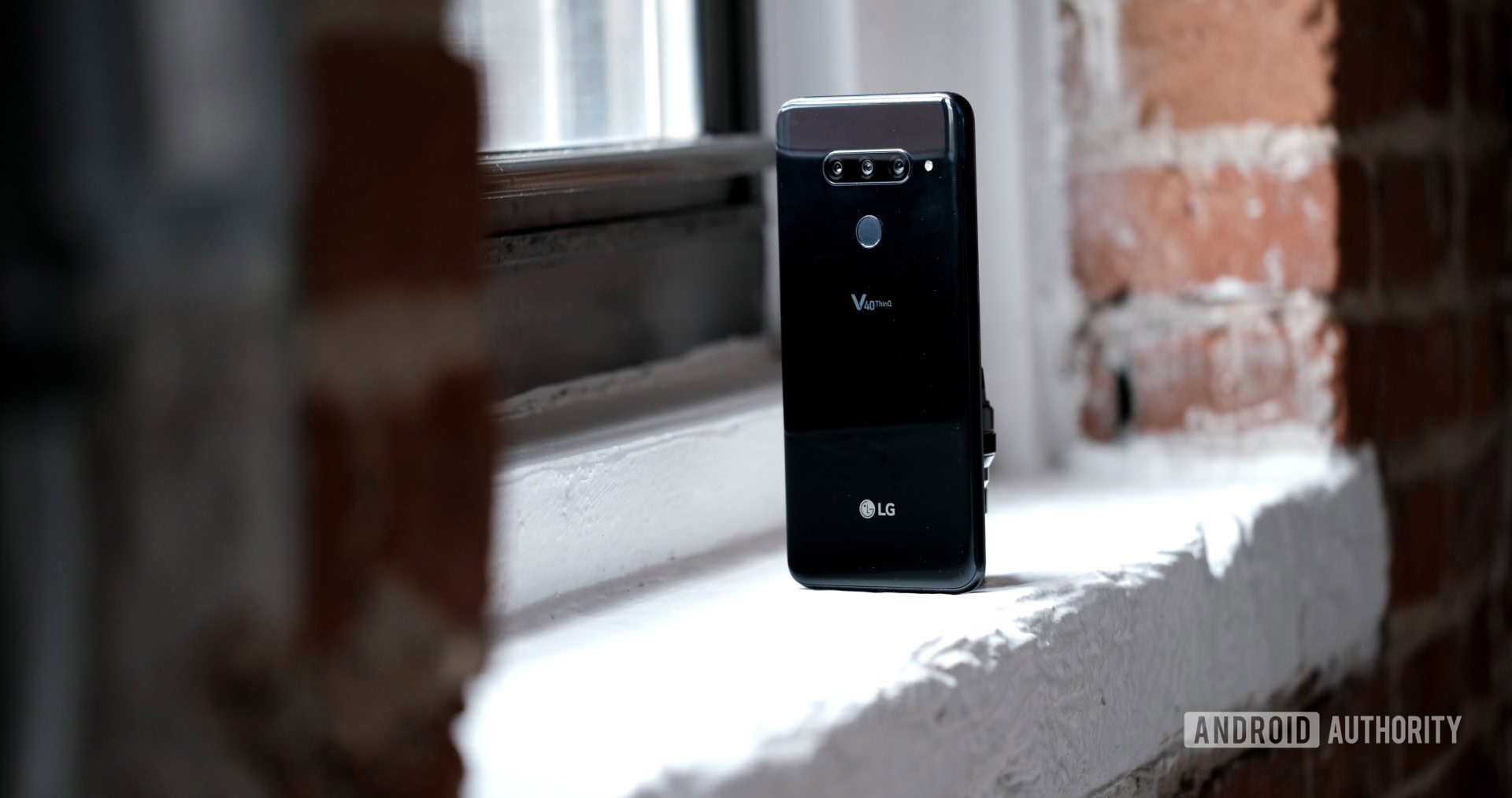Affiliate links on Android Authority may earn us a commission. Learn more.
LG V40 ThinQ vs the competition
Published onOctober 4, 2018
We could pick plenty of 2018 flagship phones to stack up against the brand new LG V40 ThinQ, but let’s focus ones with the best camera experiences — one of the phone’s major selling points. To that aim, let’s throw the ever popular Google Pixel 2 XL, HUAWEI’s triple-camera P20 Pro, and the latest Samsung Galaxy Note 9 into the ring and see who comes out on top.
Performance isn’t the battleground
None of these smartphones will leave you wanting for performance. The Qualcomm Snapdragon 845 inside the LG V40 ThinQ is roughly comparable to Samsung’s Exynos 9810 and HUAWEI’s Kirin 970. The older Google Pixel 2 XL’s Snapdragon 835 and smaller 4GB RAM capacity is a marginally weaker configuration, but not so much that you’ll notice performance drops during day-to-day tasks. Those with an insatiable lust for the very best performance and stock Android may want to wait just a little bit longer for the Pixel 3. Otherwise, performance shouldn’t be the deciding factor when picking between these phones.
| LG V40 ThinQ | Samsung Galaxy Note 9 | HUAWEI P20 Pro | Google Pixel 2 XL | |
|---|---|---|---|---|
Display | LG V40 ThinQ 6.4-inch P-OLED FullVision 3,120 x 1,440 resolution (Quad HD+) 538ppi Corning Gorilla Glass 5 18:9 aspect ratio | Samsung Galaxy Note 9 6.4-inch Super AMOLED 2,960 x 1,440 resolution (Quad HD+) 516ppi 18.5:9 screen ratio | HUAWEI P20 Pro 6.1-inch HUAWEI FullView OLED 2,240 x 1,080 resolution (FHD+) 408ppi 18.7:9 aspect ratio | Google Pixel 2 XL 6.0-inch pOLED 2,880 x 1,440 resolution (Quad HD+) 537ppi Corning Gorilla Glass 5 18:9 aspect ratio |
Processor | LG V40 ThinQ 10nm, octa-core Qualcomm Snapdragon 845 | Samsung Galaxy Note 9 Global: 10nm, octa-core Samsung Exynos 9810 (2.8 GHz quad + 1.7 GHz quad) U.S.: 10nm, octa-core Qualcomm Snapdragon 845 | HUAWEI P20 Pro HUAWEI Kirin 970 Octa-core CPU (4 Cortex A73 2.36GHz + 4 Cortex A53 1.8GHz) + NPU | Google Pixel 2 XL 10nm, octa-core Qualcomm Snapdragon 835 |
GPU | LG V40 ThinQ Adreno 630 | Samsung Galaxy Note 9 ARM Mali-G72 MP18 (Exynos) Adreno 630 (Snapdragon) | HUAWEI P20 Pro Mali-G72 MP12 | Google Pixel 2 XL Adreno 540 |
RAM | LG V40 ThinQ 6GB LPDDR4x | Samsung Galaxy Note 9 6 or 8GB LPDDR4x | HUAWEI P20 Pro 6GB LPDDR4x | Google Pixel 2 XL 4GB LPDDR4X |
Storage | LG V40 ThinQ 64 or 128GB UFS 2.1 MicroSD expansion up to 2TB | Samsung Galaxy Note 9 128 or 512GB MicroSD expansion up to 512GB | HUAWEI P20 Pro 128GB No microSD card | Google Pixel 2 XL 64 or 128GB No microSD card |
Dimensions and weight | LG V40 ThinQ 158.7 x 75.6 x 7.6mm 168.9g | Samsung Galaxy Note 9 161.9 x 76.4 x 8.8mm 201g | HUAWEI P20 Pro 155.0 x 73.9 x 7.8mm 180g | Google Pixel 2 XL 157.9 x 76.7 x 7.9mm 175g |
Similarly, all of these phones look razor sharp and boast colorful and bright screens. Even the P20 Pro’s lower FHD+ resolution is plenty in a 6-inch form factor. Remember, both Samsung’s Note 9 and LG’s V40 default to a FHD+ resolution to save on battery life. We will give an edge to the Samsung Galaxy Note 9 here, as the display giant has reserved some of its finest AMOLED panels ever produced for the Galaxy Note 9. LG Display’s pOLED technology inside the Pixel 2 XL receive a bit of a bad rep shortly after launch, but many of the complaints were overblown. If you’re an avid notch hater, you’ll probably not be too happy with the look of the HUAWEI P20 Pro and the LG V40.
Storage configurations are more worth bearing in mind, and there’s a clear winner here if you have a big media library. The Samsung Galaxy Note 9’s most expensive model offers a huge 512GB of internal storage plus microSD card slot if you require more. The LG V40 ThinQ’s 64GB option is on the small side for a modern flagship but external storage can help, and there’s a 128GB model for those living outside the U.S. Unfortunately the same isn’t true for the P20 Pro and Pixel 2.

Triple threat cameras
The HUAWEI P20 Pro was the first phone with a triple camera configuration, and now the LG V40 ThinQ matches it on the back and goes further on the front, with two sensors.
These triple-camera setups are pretty different though. Much like the Galaxy Note 9, the V40 focuses on wide angle capabilities, augmented with a 2x telephoto lens for zooming in. The V40 has a super wide-angle camera with a 16MP resolution to fit everything into the shot. Each camera acts mostly as a standalone unit, offering a separate shooting option. Additionally, LG’s Cine Shot feature combines all three for a seriously cool effect, and Triple Shot lets you shoot with all three at once.
Both the V40 and Note 9 also offer optical image stabilization, making them great at moving shots and low light photography. The P20 Pro gets around this with some clever stabilization software, and its night mode remains one of the most impressive photography software algorithms I’ve ever used.
It takes great pictures, but the Pixel 2 is the least flexible shooter out of the four.
The HUAWEI P20 Pro’s cameras are a little more closely integrated than other multi-sensor setups. The 20MP monochrome sensor improves the dynamic range and reduces noise. The 3x telephoto lens combines with the main sensor, bumping the P20 Pro’s Hybrid Zoom technology up to 5x and making it the king of capturing long distance shots. The P20 Pro also boasts a switchable 40MP to 10MP pixel binning main sensor, making it a highly versatile shooter for better detail in bright and low light.
Meanwhile, the Pixel 2 range takes perfectly good pictures with just a single camera, relying heavily on Google’s HDR+ software to capture very well exposed shots. More isn’t always better, but multi-camera setups generally allow for greater shooting flexibility. The winner will depend on what type of photos you like to take.

All the other features
These days, flagships need plenty of extras to separate them from today’s compelling mid-range phones. The Samsung Galaxy Note 9 sets a high bar, with fast wireless charging, face scan biometric security, Samsung Pay, Dex, IP68 water resistance, and the S Pen of course (and also the Bixby button).
The LG V40 ThinQ similarly brings integrated Qi wireless charging, a Google Assistant button, and IP68 rating. The phone attempts to stand out on its own with MIL-STD 810G certification too, as well as its high-end headphone jack hardware. This certainly isn’t a bad list of extra features.
| LG V40 ThinQ | Samsung Galaxy Note 9 | HUAWEI P20 Pro | Google Pixel 2 XL | |
|---|---|---|---|---|
Cameras | LG V40 ThinQ Rear: Main camera: 12MP sensor, ƒ/1.5 aperture, 78° field-of-view, 1.4µm pixel size, OIS, Dual PD Autofocus Super wide: 16MP sensor, ƒ/1.9 aperture, Crystal Clear Lens, 107° field-of-view 2x telephoto zoom: 12MP sensor with 45° field of view Front: Standard: 8MP sensor, ƒ/1.9 aperture, 1.12µm pixel size, 80° field-of-view Wide: 5MP sensor, ƒ/2.2 aperture, 1µm pixel size, 90° field-of-view | Samsung Galaxy Note 9 Rear: Dual camera with dual OIS Wide-angle: Super Speed Dual Pixel 12MP AF sensor with OIS, f/1.5 and f/2.4 apertures Telephoto: 12MP AF sensor, f/2.4 aperture, 2x zoom Front: 8MP AF sensor, f/1.7 aperture | HUAWEI P20 Pro Rear: 40MP RGB f/1.8 + 20MP monochrome f/1.6 + 8MP telephoto f/2.4 with OIS dual-LED flash, PDAF+CAF+Laser+Depth auto focus, 3X optical zoom, 5X Hybrid Zoom Front: 24MP sensor with an f/2.0 aperture, fixed focus | Google Pixel 2 XL Rear: 12.2 MP sensor with f/1.8 aperture, laser autofocus, OIS & EIS Front: 8 MP sensor with f/2.4 aperture, fixed focus |
Audio | LG V40 ThinQ Boombox Speaker DTS:X 3D Surround Sound Hi-Fi Quad DAC 3.5mm headphone jack | Samsung Galaxy Note 9 Stereo speakers tuned by AKG, surround sound with Dolby Atmos technology 3.5mm headphone jack | HUAWEI P20 Pro Stereo speakers USB Type-C headphones | Google Pixel 2 XL Stereo speakers USB Type-C headphones |
Battery | LG V40 ThinQ 3,300mAh Non-removable Wireless charging Qualcomm Quick Charge 4 (ships with QC 3.0 charger) USB Type-C port | Samsung Galaxy Note 9 4,000mAh battery Non-removable Fast wired charging compatible with QC 2.0 Fast wireless charging compatible with WPC and PMA | HUAWEI P20 Pro 4,000mAh Non-removable HUAWEI SuperCharge | Google Pixel 2 XL 3,520 mAh Non-removable USB Power Delivery |
IP rating / other certifications | LG V40 ThinQ IP68 MIL-STD 810G | Samsung Galaxy Note 9 IP68 | HUAWEI P20 Pro IP67 | Google Pixel 2 XL IP67 |
Connectivity | LG V40 ThinQ Wi-Fi 802.11ac Bluetooth 5.0 NFC | Samsung Galaxy Note 9 Wi-Fi 802.11ac Bluetooth v5.0 NFC | HUAWEI P20 Pro Wi-Fi 802.11ac Bluetooth v4,2 NFC | Google Pixel 2 XL Wi-Fi 802.11ac Bluetooth v5.0 NFC |
Software | LG V40 ThinQ Android 8.1 Oreo LG UX 6.0+ | Samsung Galaxy Note 9 Android 8.1 Oreo Samsung Experience | HUAWEI P20 Pro Android 8.1 Oreo EMUI 8.1 | Google Pixel 2 XL Android 8.0 Oreo (9.0 Pie upgrade) |
The HUAWEI P20 Pro lags behind in this regard. It’s charging tech is one of the fastest around, but there’s no wireless charging, no Bluetooth 5.0, and no headphone jack either. EMUI Desktop probably won’t appeal to many consumers, but its face recognition technology is blazingly fast.
The Pixel 2 feels a little barebones too. Although it is upgradable to Android Pie right now, and so has a few extra software tricks up its sleeve.
With all of this tech onboard, you’ll want a big battery to get the most of your phone throughout the day. This is where the LG V40 fails to keep up with its rivals. The 3,300mAh isn’t large by today’s standards. The Pixel 2 XL is a tad larger, but the Note 9 and P20 Pro set the bar with big 4,000mAh mark. All of these phones should last you a day, but handsets with larger batteries will likely take you into a second.
The V40's feature list shares a lot of similarities to the Note 9.

The V40 ThinQ is surely LG’s best entry in the V-series so far. It ticks virtually all of the major boxes for a power user’s smartphone. The comparatively small battery capacity is unfortunate and its separated triple camera setup feels like a little bit of a missed opportunity, but that’s being rather picky.
Even so, LG and Samsung continue to pack in more features than most manufacturers, including HUAWEI and Google.
Media focused users will probably lean towards the V40, though the Galaxy Note 9 offers a slightly more well-rounded experience. Photography buffs may still feel torn between all of these options.
Who do you think comes out ahead in the LG V40 ThinQ vs the competition? Also, be sure to check out our other LG V40 coverage below: